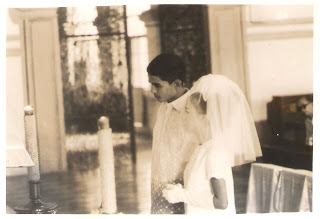 On ne voit bien qu'avec le coeur. L'essentiel est invisible pour les yeux. -Antoine de Saint-Exupery, Le Petit Prince
On ne voit bien qu'avec le coeur. L'essentiel est invisible pour les yeux. -Antoine de Saint-Exupery, Le Petit PrinceWhen my classmate Kay mentioned her new scholarly interests- anthropology and intangible cultural heritage- one of the culturally significant tales I thought of was the legend of Ho Hoan Kiem or Returned Sword Lake. You can see the lake in the middle ground of the picture, taken on a terrace of an outdoor cafe in Hanoi's historical district.
When I first rode a cyclo around Ho Hoan Kiem, I was reminded of the lake in Burnham Park in the mountain city of Baguio where my brothers and I spent summers biking. I didn't think much of Ho Hoan Kiem until I read about the legend surrounding it that transformed it in my eyes into an emerald jewel: here was an invisible key to understanding Vietnam and its people.
Here is how Nguyen Van Ky tells the legend in the book Hanoi: City of the Rising Dragon, co-authored with Frenchman Georges Boudarel:
One of Hanoi's most famous legends is that of Returned Sword Lake. It is said that a mythical tortoise gave its sacred sword to King Le Lot (r. 1428-33), allowing him to expel the occupying forces of the Chinese Ming dynasty in the fifteenth century after ten years of resistance. The people from Hanoi also love to tell stories about the etymological origins of Thang Long, the city's first name. When the boats of Ly Cong Uan, the founder of the eleventh-century Ly dynasty, arrived on the site from Hoa Lu, a golden dragon appeared to welcome them and then flew off into the sky. This good omen convinced the king to build the capital there, calling it Thang Long, which means "the rising dragon."The divine sword is said to have been "restored" since, after King Le Lot's victory over foreign invaders and while he was boating on the lake, the golden tortoise emerged from the deep once more and took back the sacred blade that the gods gave the king to save his people.
In the Philippines, an etymological legend about a lake I've come across is that of Lake Lanao- said to have been created by angels- which is why I'm drawn to visit the land of the Maranao, the People of the Lake, someday.






























